The 250th Anniversary Breguet Classique Ref. 7225 Sets A New Standard For Precision
With surprisingly little fanfare, Breguet launches one of the most accurate watches ever made.
It’s difficult to think of a single objective which more than any other, characterizes the work of Breguet, but you could make a solid argument that if there was one subject that occupied his grey matter more than anything else, it was the pursuit of precision. There was hardly an area of watchmaking relevant to precision horology to which he didn’t devote his attention, and his work on escapements, antishock protection, problems in isochronism, issues pertaining to balance poise, balance spring dynamics, and many other subjects were all subject to investigation and experimentation. His inventions influenced precision timekeeping long after his death in 1823, at the age of 76, and he has proven a hard act to follow, both at the company he founded and in watchmaking in general. Montres Breguet, which was acquired by Swatch Group from Investcorp in 1999, recently announced a new watch as part of its 250th anniversary celebrations, which it says can be expected deliver a precision of ± 1 second per day.
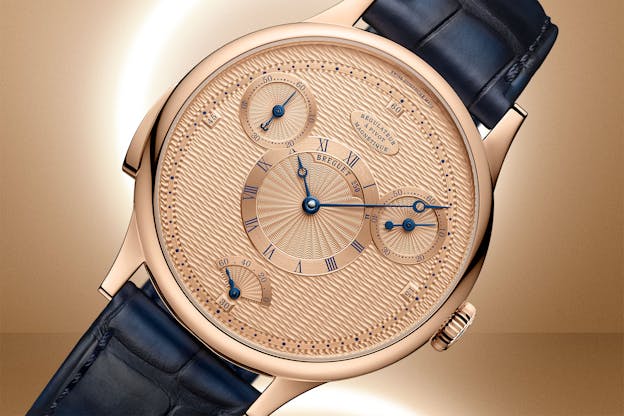
That watch is the Classique ref. 7225, which at first glance looks like a minute repeater thanks to the slide on the left side of the case. The design of the watch is a deliberate shout out to Breguet’s obsession with precision – it’s taken from the famous pocket watch, Breguet no. 1176, which is a four minute garde-temps tourbillon, with natural escapement, which was sold to Count Stanislas Kostka Potocki, in 1809.
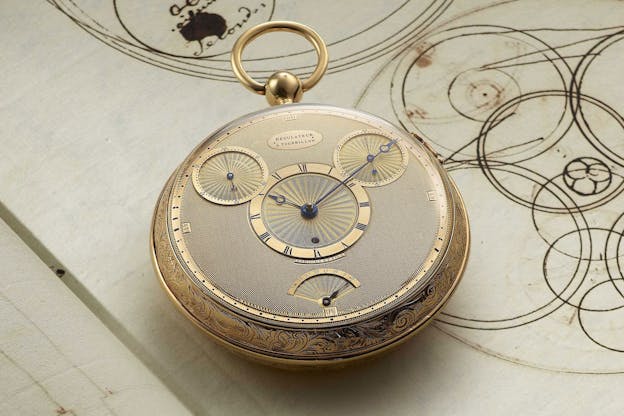
The 7225 uses two innovations which Breguet originally launched in 2012, in the Classique Chronometrie ref. 7727. The first of these innovations is a 10Hz escapement; that is, one that beats at 72,000 vph. High beat escapements are unusual in watchmaking, although not unique – Zenith and Grand Seiko, for instance, both make 36,000 vph movements in a number of different models, but there have been vanishingly few production watches which run at a higher beat, much less twice the beat of a 36,000 vph watch . Most modern movements run at 28,800 vph and a higher frequency balance should, all other things being equal, offer greater precision as the higher the frequency of an oscillator, the more stable it tends to be, as it better resists physical disturbances than a lower frequency oscillator. The second innovation is one which is as far as I know, unique to Breguet: the use of a magnetic suspension system for the balance staff pivots. The movement of the ref. 7225 also uses two silicon balance springs, a silicon lever, and an extremely intricately detailed escape wheel.
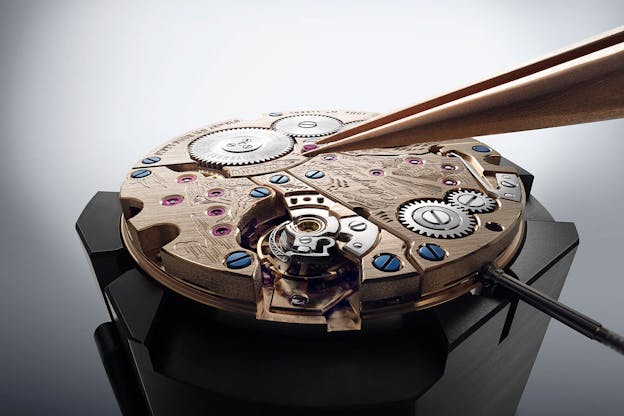
This unusual arrangement in caliber 74SC can be seen in the above image; the balance, balance springs, and magnetic pivots are immediately and noticeably different from what you’d see in a conventional watch. The attachment points on the balance staff are aligned so that the two springs cancel out any asymmetries in their oscillations. As there are no conventional regulators, the balance is freesprung, with four adjustable meantime screws set into recesses in the rim.

The magnetic suspension system for the balance pivots consists of two powerful permanent magnets which are located at either end of the balance staff. The magnets are quite powerful with, according to Breguet, a strength of 1.3 Tesla, or 13,000 gauss. There is a slight asymmetry in the magnetic field lines created by the magnets, which causes one of the two ends of the balance staff to be constantly pressed against one of the cap jewels. In a conventional balance, the friction exerted by the balance pivots in their jewels and against the endstones will vary depending on positions and it will particularly vary between the vertical and horizontal positions, partly due to variations in the poise of the balance in different positions, and partly due to the fact that in the vertical positions, the sides of the balance pivots press on the pivot jewels, while in the vertical positions, most of the contact of the balance staff is on one or the other of the balance staff tips.
With the magnetic suspension system, all of these variations in poise and friction in different positions are largely eliminated, as the point of contact of the balance staff remains constant, no matter the position of the watch.
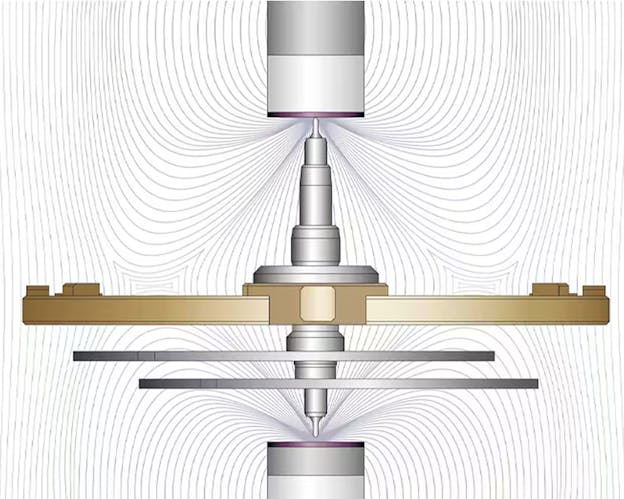
The system is also inherently shock resistant and the magnetic suspension system means that if any shock is given to the watch, and the balance staff is jolted out of position, it will return to the correct position virtually instantaneously.
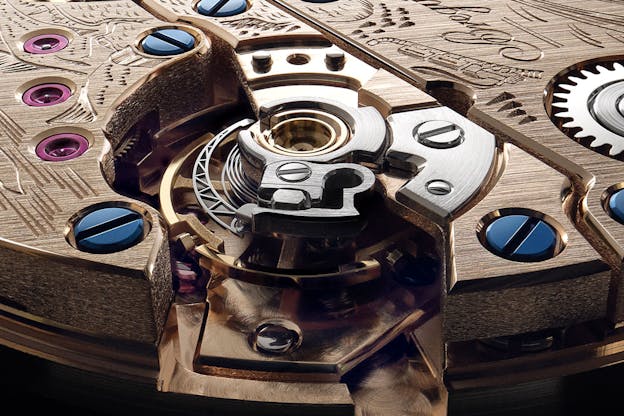
Although the balance springs, lever, and escape wheel are silicon, the lever, interesting enough, uses conventional ruby pallets.
Normally, putting a couple of powerful permanent magnets inside a watch is about the last thing you would ever want to do; for most of the history of watchmaking, magnetic fields were something you wanted to keep as far away from the plain steel balance springs and other steel components used in watchmaking as you possibly could. The invention of Nivarox type alloys reduced but did not eliminate the severity of the problem, and it was really only conquered definitively by the introduction of silicon components. All of the essential regulating components in the ref. 7225 are made of silicon, and while the magnets for the balance pivots are obviously quite strong in terms of local field strength, magnetic field strength falls off very quickly with distance – think about how hard it is to separate two magnets if they’re stuck together, but how easy it is to get them further apart once there’s even a slight distance between them.

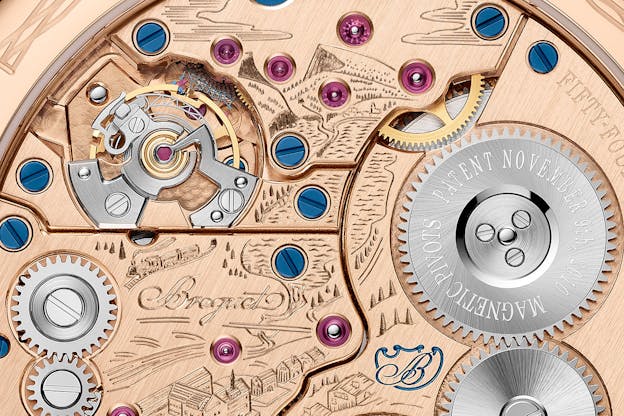
The movement plates and bridges are decorated with engraving which depicts the Breguet manufacture in Le Chenit, in the Vallée de Joux, looking to the west across the Lac de Joux, with the mountain known as the Dent de Vaulion towering over the western end of the lake. Just above the engraved “Breguet” you can see an engraving of one of the steam trains which were part of the economic development of the Vallée de Joux, starting in the late 19th; the Vallée was a source of both timber and iron ore. If you look very closely, just above the balance, you’ll be able to make out the silicon escape wheel, which is a sort of Easter egg for sharp eyed owners.

The escape wheel has been etched in such a way that the interstices of the body of the wheel spell out 1725 or 2025, and if you get a chance to see the watch in action, you’ll be able to see that the escape wheel functions as a kind of phenakistoscope – if you are not familiar with the term, and there’s no reason why you should be, it refers to an early mechanical device for viewing animated images. When the escape wheel’s in motion, it creates the illusion of the year shown smoothly flowing from 1775 to 2025 and back, which is something I can’t help but think Breguet would have found delightful, while at the same time he probably would have been astounded at modern advances in precision machining. It’s blink-or-you-miss-it, but you just see the effect at about 24 seconds, in Breguet’s promotional YouTube video.
Now the obvious 64,000 dollar question is this: does the watch deliver on the precision promised by its high frequency and other innovations? Breguet currently has three classifications for precision for its watches; these are Evening (-2/+6 seconds, which is already better than the COSC chronometer spec); Civilian (± 2 seconds per day); and Scientific (±1 second per day). The “Scientific” spec is the tightest in the industry for mechanical watches, surpassing both COSC and Master Chronometer specifications, as well as the in-house precision specs for any other watchmaker. The ref. 7225 keeps time, according to Breguet, to ± 1 second per day, which puts it in the Scientific class. As far as I know, this is a category with, at least so far, just one watch in it, which is the 7225; even its predecessor, the ref. 7727 Classique Chronometrie, is rated to -1/+3 seconds per day. The only other watch I know of which achieves essentially the same performance, is the Omega Speedmaster Super Racing, which uses the recently announced Spirate fine adjusting system, and which has a precision of 0/+2 seconds per day.
It’s interesting that the ref. 7225 has a better precision spec than the ref. 7727, despite the two using the same system; I assume there were some tweaks to either manufacturing or adjusting or both which yielded the improvement. In the meantime, the combination of a 10Hz frequency and the magnetic pivot system show that advances in basic mechanical horology are not only possible, but that they can also yield tangible results.
The Breguet Classique ref. 7225/7225BH0H9V6; case, Breguet Gold (18k gold alloy combining gold, copper, silver and palladium, developed for the 250th anniversary year) 41mm x 10.7mm, “Quai de l’Horloge” caseband guilloché engraving; sapphire crystals front and back; water resistance, 30 meters. Dial, 18k Breguet Gold, with “Quai de l’Horloge” guilloché; blue gold hour and minute hands, blued seconds hands and power reserve hand.
Movement, Breguet caliber 74SC, 16 ligne/35mm diameter x 5.5mm, hand wound, running at 10Hz/72,000 vph in 54 jewels. Flat double silicon balance springs, silicon lever and escape wheel; “observation” seconds with flyback function. Magnetic bearing system for the balance pivots. 60 hour power reserve.
Non-limited edition; price at launch CHF 75,000. The 1916 Company is proud to be an authorized retailer for Montres Breguet; contact us for pricing and availability.

